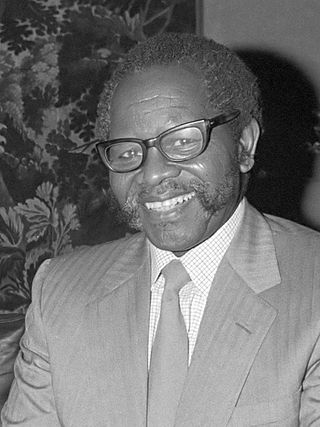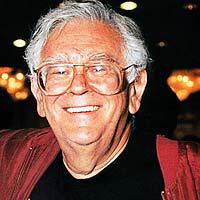
Oliver Reginald Kaizana Tambo was a South African anti-apartheid politician and activist who served as President of the African National Congress (ANC) from 1967 to 1991.

Joe Slovo was a South African politician, and an opponent of the apartheid system. A Marxist-Leninist, he was a long-time leader and theorist in the South African Communist Party (SACP), a leading member of the African National Congress (ANC), and a commander of the ANC's military wing uMkhonto we Sizwe (MK).

Heloise Ruth First OLG was a South African anti-apartheid activist and scholar. She was assassinated in Mozambique, where she was working in exile, by a parcel bomb built by South African police.
Bertil Wedin was a Swedish secret service agent. He was accused in an English court, but acquitted of the 1982 burglary of the Pan Africanist Congress (PAC) office in London. In 1996, Wedin was named as a suspect in the assassination of Sweden's prime minister, Olof Palme, but has denied any involvement. His accuser, Peter Caselton – who with eight others including Craig Williamson had applied for amnesty from South Africa's Truth and Reconciliation Commission for the March 1982 bombing of the ANC office in London – was allegedly a member of an apartheid South Africa assassination squad. He was also suspected of bombing the ANC Stockholm office in 1986. Wedin denies involvement in any crimes.
The International Freedom Foundation (IFF) was a self-described anti-communist group established in Washington, D.C. founded in 1986 by former lobbyist Jack Abramoff. Its purported aim was to promote individual and collective freedoms worldwide: freedom of thought; free speech; free association; free enterprise; and, the free market principle. It came into being after the Democratic International, a 1985 meeting of anti-Communist rebels held at the headquarters of UNITA in Jamba, Angola. The IFF campaigned against regimes and movements it described as Soviet allies. To achieve its aim the IFF, with offices in London and Johannesburg, sponsored symposia with high-profile speakers such as Henry Kissinger. Among its eight periodicals, the IFF published a monthly newsletter—the Freedom Bulletin—with three editions: International; UK/Europe; and, Republic of South Africa. The IFF ceased its activities in 1993.

On 28 February 1986, at 23:21 CET, Olof Palme, Prime Minister of Sweden, was fatally wounded by a single gunshot while walking home from a cinema with his wife Lisbeth Palme on the central Stockholm street Sveavägen. Lisbeth Palme was slightly wounded by a second shot. The couple did not have bodyguards with them.
The Church Street bombing was a car bomb attack on 20 May 1983 in the South African capital Pretoria by uMkhonto we Sizwe (MK), the paramilitary wing of the African National Congress. The bombing killed 19 people, including the two perpetrators, and wounded 217.

Catch a Fire is a 2006 biographical thriller film about activists against apartheid in South Africa. The film was directed by Phillip Noyce, from a screenplay written by Shawn Slovo. Slovo's father, Joe Slovo, and mother Ruth First, leaders of the South African Communist Party and activists in the Anti-Apartheid Movement, appear as characters in the film, while her sister, Robyn Slovo, is one of the film's producers and also plays their mother Ruth First. Catch a Fire was filmed on location in South Africa, Swaziland and Mozambique.
The South African Civil Cooperation Bureau (CCB), was a government-sponsored death squad, during the apartheid era. The CCB, operated under the authority of Defence Minister General Magnus Malan. The Truth and Reconciliation Committee pronounced the CCB guilty of numerous killings, and suspected more killings.
Dirk Coetzee was co-founder and commander of the covert South African Security Police unit based at Vlakplaas. He and his colleagues were involved in a number of extrajudicial killings including that of Griffiths Mxenge. Coetzee publicly revealed the existence of the Vlakplaas death squads in 1989, making himself a target of a failed assassination attempt.

Red Dust is a 2000 novel written by South African-born Gillian Slovo that is structured around the hearings of the Truth and Reconciliation Commission (TRC) in the fictional town Smitsrivier and also addresses the question of truth.
Neville Wilson Curtis was an anti-apartheid activist and leader of the National Union of South African Students.
Linda Mvusi is an actress and architect. Mvusi took an award for best actress at the 1988 Cannes Film Festival for her role in the film A World Apart which was directed by Chris Menges. Mvusi was the first South African to get a best Actress award at Cannes. Mvusi also shared in an award for excellence for her architecture on the Apartheid Museum.
The International Defence and Aid Fund or IDAF was a fund created by John Collins during the 1956 Treason Trial in South Africa. After learning of those accused of treason for protesting against apartheid, including Nelson Mandela, Collins created the fund in order to pay all legal expenses and look after the families of those on trial. The group was non-partisan.
Louis Marius Schoon was a white anti-apartheid activist of Afrikaner descent. Marius died from lung cancer, after a long call from Nelson Mandela, thanking him for his sacrifice against the struggle.

South Africa–Sweden relations refers to the bilateral relations between Sweden and South Africa. Formal relations between the two countries began with the opening of a South African legation in the 1930s with relations being upgraded to ambassadorial level in 1994 following South Africa's first non-racial democratic elections. In 2000 a South African - Swedish Binational Commission was established by President Thabo Mbeki and Prime Minister Göran Persson.
Chris Hani, General-Secretary of the South African Communist Party (SACP), was assassinated by right-wing extremist Janusz Waluś on 10 April 1993. The assassination, later tied to members within the Conservative Party, occurred outside Hani's home in Dawn Park during a peak period of progressive anti-apartheid momentum in South Africa. After the assassination, racially fuelled riots drew international attention to the instability of the political division within South Africa, leading to an inclusive national democratic election in April 1994, won by the African National Congress (ANC). Waluś and his accomplice Clive Derby-Lewis were sentenced to death after their arrest in 1993; the sentence was later commuted to life imprisonment.

The Security Branch of the South African Police, established in 1947 as the Special Branch, was the security police apparatus of the apartheid state in South Africa. From the 1960s to the 1980s, it was one of the three main state entities responsible for intelligence gathering, the others being the Bureau for State Security and the Military Intelligence division of the South African Defence Force. In 1987, at its peak, the Security Branch accounted for only thirteen percent of police personnel, but it wielded great influence as the "elite" service of the police.
Jeanette Eva Schoon was a South African anti-apartheid activist. She and her daughter, Katryn Schoon, were killed by letter bomb in June 1984 in an operation carried out by the Security Branch of the South African Police.







